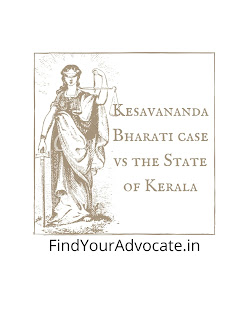What is Kesavananda Bharati case vs State of Kerala - FindYourAdvocate
Basic Structure Doctrine: Kesavananda Bharati Case / Kesavananda Bharati case vs the State of Kerala
INTRODUCTION / What is the Keshav Bharati case?
Keshvanand Bharati turned into the chief of Edneer Mutt, a non-secular institution withinside the Kasaragod district of Kerala. Keshvananda Bharti had numerous chunks of land withinside the congregation that he owned in his possession. The State Government of Kerala enacted the Land Reforms Amendment Act of 1969. As in keeping with the act, the authority turned into entitled to buy a number of the land of the religion, the top of which turned into Keshvanand Bharti.
On 21 March 1970, Kesavananda Bharti moved to the Supreme Court pursuant to Section 32 of the Indian Constitution for the safety of his rights granted beneath Neath Article 25 (Right to Exercise and Spread Religion), Article 26 (Right to Pursue Religious Affairs), Article 14.
ARGUMENTS RAISED
The plaintiff argued that the Parliament can't alternate the Constitution in anything way it needs, because it has little authority to do so. The Parliament can't assert its energy to alternate the Constitution via way of means of changing its Basic Structure, as turned into cautioned via way of means of Justice Mudhokar withinside the case of Sajjan Singh v State of Rajasthan. The applicant appealed for the safety of his land in compliance with Article 19(1)(f) of the Indian Constitution.
It turned into claimed that the twenty-fourth and twenty-fifth constitutional amendments violated the fundamental proper indexed in article 19(1)(f) of the Indian Constitution. Fundamental rights are the rights relevant to the human beings of India to make certain independence, and if any constitutional conference removes that proper, the liberty granted to the residents of India beneath Neath the Constitution can be stripped far from them.
The State turned into the respondent. The State claimed that the sovereignty of the Parliament is the essential premise of the Indian criminal machine and consequently the Parliament has unrestricted authority to amend the Constitution. The State additionally argued that, if you want to satisfy its social and financial obligations promised to the human beings of India beneath Neath the Preamble, it's far vital for the Parliament to exercise its powers to amend the Constitution past restriction.
ANALYSIS
According to the doctrine, the Parliament has complete authority to amend the Constitution at the completely assessed those sure amendments do now no longer alter the Basic Structure of the Constitution. Parliament does now no longer mess in any manner with the Basic Structure of the Constitution, without which our Constitution could be left unspiritual and could sacrifice its very meaning. The Basic Structure of the Constitution has now no longer been said via way of means of the bench and has been left to the information of the courts. The Courts maintain to peer and interpret whether or not or now no longer a selected provision is contradictory to the Basic Structure of our Indian Constitution.
The Kesavananda Bharati choice followed the Basic Structure Doctrine, which restrained Parliament’s cap potential to make radical reforms that would affect the middle ideas included via way of means of the Constitution, together with secularism and federalism. The choice affirmed the authority of the Supreme Court to study the legal guidelines of Parliament on a judicial basis. The definition of the department of powers among the 3 divisions of governance—legislative, government, and judicial—has evolved.
JUDGEMENT of Kesavananda Bharati case vs the State of Kerala
The landmark judgment turned into added via way of means of a slender majority of 7:6 on 24 April 1973, wherein the bulk dominated that each clause of the Indian Constitution will be modified via way of means of Parliament if you want to meet its socio-financial obligations promised to human beings as set out withinside the Preamble, imparting that such modification did now no longer alter the Basic Structure of the Constitution.
The minority, but, is cautious, of their opposite opinion, of granting Parliament unrestricted energy of modification.
The Court dominated that the twenty-fourth modification to the Constitution turned into absolutely legitimate. But the second part of the twenty-fifth constitutional modification turned into taken into consideration to be extremely vires.
ISSUE RAISED
The volume to which the Parliament can exercise its energy to amend the Constitution?
The courtroom docket located that the term ‘modification’ utilized in Article 368 could now no longer practice modifications which can also additionally alter the Basic Structure of the constitution. If Parliament needs to amend a sure clause of the Constitution, the modification will need to skip the take a look at of the Basic Structure.
It turned into additionally agreed that, due to the fact the Parliament has unrestricted powers to amend the Constitution in line with the fundamental shape, the Parliament can but amend the Constitutional Rights in a lot as they may be now no longer contained withinside the fundamental shape of the Constitution.
CONCLUSION
The majority of the Board needed to hold the Constitution of India via way of means of keeping the Basic Structure of the Constitution. The verdict turned into an issue after the observation of the various factors and turned into centered on rational logic. The Bench claimed that if the Parliament has been to have unrestricted authority to amend our Indian Constitution, the energy could be misappropriated and changed via way of means of the Government in compliance with its very own will and desires. The Basic Structure and the very spirit of the Law may be changed via way of means of the Government if it has unrestricted authority to amend it. There turned into a choice for a doctrine to shield the pursuits of each Parliament and human beings, and so the Bench got here into being.
The ground-breaking case of Keshavananda Bharti supplied the Constitution with continuity. While the appellant defeated his case in part, the judgment surpassed down via way of means of the Court, on this case, became out to be a protector of Indian democracy and rescued the Constitution from dropping its essence.










Comments
Post a Comment